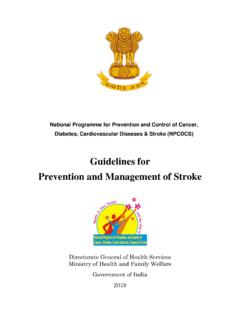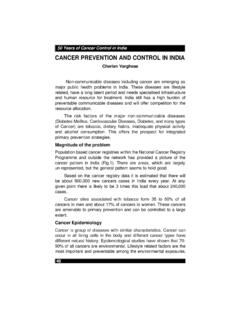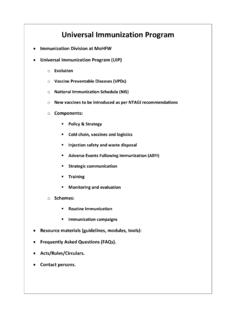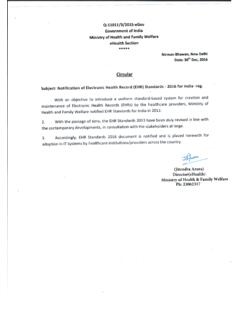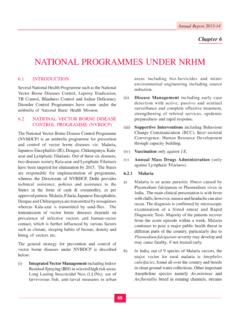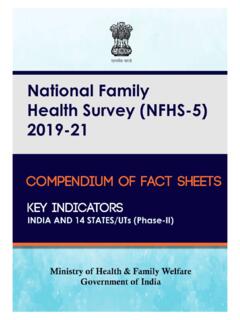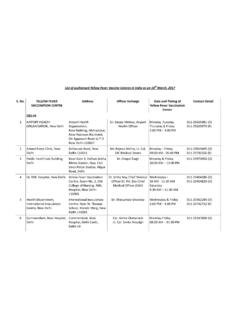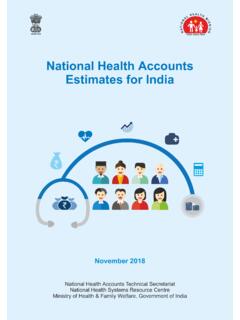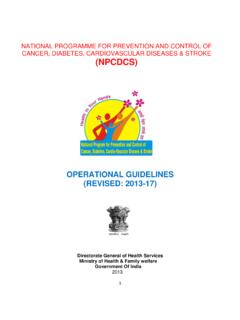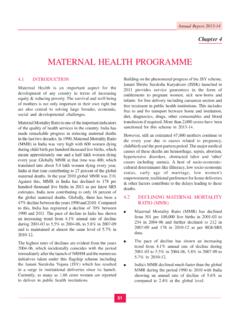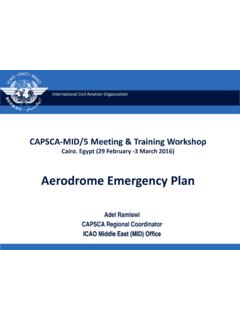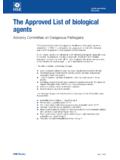Transcription of National Guidelines for Engagement of Housekeeping ...
1 2015 KAYA KALP National Guidelines for Clean Hospitals Applicable to Tertiary Care Hospitals, Hospitals associated with Medical Colleges & Super-specialty Hospitals in India 2015 MINISTRY OF HEALTH AND FAMILY WELFARE GOVERNMENT OF INDIA 2015 2015 National Guidelines for Clean Hospitals Tertiary Care Hospitals, Hospitals associated with Medical Colleges & Super-specialty Hospitals Disclaimer These Guidelines are generic in nature and healthcare organizations are advised to adapt them judiciously In addition to the prescribed Guidelines for sanitation, healthcare organizations must comply with any statutory or legal obligations from time to time Year 2015 Note.
2 References have been quoted in parenthesis ( ) wherever required 2015 Executive Summary A committee under the Chairmanship of Medical Superintendent, AIIMS, New Delhi was constituted by Ministry of Health and Family Welfare, Government of India subsequent to the summary record of presentation to Hon ble Prime Minister of India, wherein it was desired that appropriate steps must be taken to change the perception and mindset of people about public hospitals through highest level of hygiene and sanitation.
3 The committee was mandated to study the existing system of Housekeeping in Government Hospitals and draft the National Guidelines for the same keeping in view the ground realities. This committee initially visited three central government hospitals in Delhi to understand the existing system of Housekeeping services. During these exploratory visits, it was observed that the Housekeeping services in these hospitals are currently being carried out in a combined manner by both in-house employees as well as outsourced staff, though the method of awarding the same to an external agency varied between the hospitals.
4 Wide disparity was observed in the management structure and staffing levels of Housekeeping services between these hospitals and officials therein expressed difficulties in developing suitable tender documents for outsourcing of such services due to lack of expertise and knowledge of Housekeeping chemicals, equipment, etc in this field. Merits and de-merits of service contract vs manpower contract for outsourcing of these services was a major dilemma for officials and was further compounded due to conflicting opinions in this regard amongst different stakeholders.
5 The ability of these hospitals to handle such issues was found to be genuinely limited vis-a-vis autonomous institutions like AIIMS-New Delhi, PGIMER-Chandigarh, etc. where doctors with professional training (postgraduate degrees in hospital administration) manage these services on a fulltime basis. Further, unlike at autonomous institutions, these hospitals despite being of almost the same or larger size, do not have an in-house engineering department and the maintenance works are carried out by the contractors appointed by the public works department.
6 The hospital authorities are not 2015 empowered to expend on even minor / urgent repair works and are totally dependent on the public works department officials - on whom they have no direct administrative control. The committee members then analyzed the tenders & contracts of these and other public & private sector hospitals to get a National perspective of the existing system and the challenges being faced therein. To find solutions to the identified problem, a detailed literature review of the existing best practices in the field of hospital sanitation & Housekeeping in India & globally was done and relevant extracts from the same were adapted with suitable changes in the final Guidelines .
7 These Guidelines focus on strengthening and streamlining of proper selection and maintenance of infrastructure, development of suitable policies for Housekeeping services, selection & training of manpower, development and implementation of suitable cleaning methods in the form of protocols / SOP s, effective supervision and monitoring by adequate staff and in-built mechanisms in the contracts coupled with an organizational structure which puts a premium on good Housekeeping and sanitation.
8 They also describe the structure of the Housekeeping department / service, roles & responsibilities of workers & supervisors, qualification, experience & training needs of sanitation staff, equipment details for mechanized cleaning, chemicals & cleaning agents to be used, etc. The Guidelines encourage that every health care setting should ideally perform their own time management studies to determine appropriate staffing levels for cleaning and supervisory staff. However, based on the experience of various stakeholders, the following broad thumb rules for Housekeeping manpower have been prescribed in the Guidelines so as to ensure appropriate 24-hour coverage in all hospital areas.
9 1 Sanitary Attendant for 2 Hospital Beds 1 Sanitary Supervisor for 12-15 Sanitary Workers 1 Sanitary Inspector for 5-7 Sanitary Supervisors 1 Sanitary Officer for 5 7 Sanitary Inspectors 2015 Taking a cue from the Spaulding s classification for disinfection and in line with the best practices, it has been recommended that for the purpose of Housekeeping , various areas in the hospital should be broadly classified as high risk, medium risk and low risk.
10 Accordingly, the frequency & type of cleaning required, standard operating procedures, key performance indicators, etc. have been detailed for each broad area. These Guidelines also lay emphasis on the availability of basic sanitation infrastructure in the form of sluice rooms, janitor cupboards, etc. in all areas, use of appropriate Housekeeping tools & equipment, laundering of re-used mops & dusters, cleaning standards, quality assurance and health & safety of sanitation staff.
